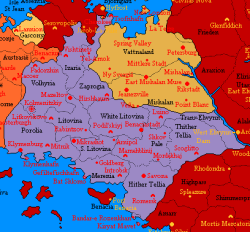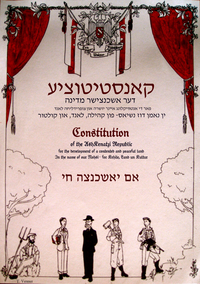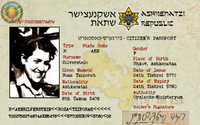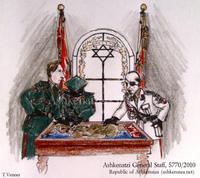Ashkenatza
The Republic of Ashkenatza was founded by Maksym Izaak Rozenthal and Hesham Jandahar in August 2008 as an experiment in creating a Secular Jewish micronation along Yiddish and Ashkenazi Culture. It was felt an overt name such as Ashkenatza would help stress the essentially Eastern European flavour of the nation, thereby alleviating any impression of an Israeli micronation Ashkenatza would cause. Founded after a period of Maximos' inactivity in Shireroth and the death of his young socialist micronation, the Kazari People's Republic, Ashkenatza was quickly joined by the remaining old guard of the former Zatriarchate of Matbaa, and developed rapidly- its existence only being released to the Micronational Community at large after the Constitution of 2008 was ratified and a Government formed. Today, Ashkenatza remains an active and prosperous micronation and is an important member of the intermicronational community.
History
Ashkenatza's appearance on the micronational stage in August 2008 was during a time of great confusion for the Anglophone Micronational community- the death of Lovely, the Grand Commonwealth, the MCS-GSO divide and the imminent closure of the Micronational News Network MNN made it very difficult to recruit new citizens, leaving Ashkenatza's citizen base a very particular one, mainly old Matbaics and Babkhans. Ashkenatza's first intermicronational step was claiming land on Benacia, immediately drawing its foreign relations closer to Shireroth, and balancing the Ashkenatzi-Babkhan closeness which had been forming. Babkhan economic and military support to Ashkenatza was highly important, as was contact with Ashkenatza's neighbour Tellia, who shared similar concerns about possible Amokolian belligerence to the North. There had, however, been disagreements with Tellia regarding land expansions, and although Tellia eventually capitulated to Ashkenatzi ownership over the Southern Litovina area, Ashkenatza guaranteed the constitutional rights of ethnic Tellian citizens living there.
Almost immediately, after the threat of war became very real, the Central Benacian Relations Conference, overseen by Shireroth and held in Romero, the capital of Tellia, agreed on a peaceful land expansion to share unclaimed inner Benacia, which allowed expansions for Amokolia, Ashkenatza, Tellia, and Ashkenatza's friendly western neighbour, Batavia. Still, the threat of war lingered and Tellia and Ashkenatza remained militarily very close, supported by Babkha- with whom, however, alliance negotiations were not incredibly successful- and the interventionist foreign policy pursued by Rozenthal, coupled with aggressive military buildup ensured Ashkenatza gained a 'causus belli' on any nation mistreating its Jewish citizens. How the widening rift between monarchist and socialist micronations in the Micras Sector will affect Ashkenatzi politics remains to be seen, but the tenuous coalition of the socialist Bundist Party and social liberal Dray Bagrif Partei under the leadership of Nohsi Laz Krakowski steered an easy goi
Geography
The Republic's oldest territories are those on Benacia, known as Metropolitan Ashkenatza, which have expanded to the west and north over time. These include the provinces of Volhyria, Porolia, Merenia, Litovina, White Litovina, South Litovina, Izaria, Zaprogia, the Pale, Tsofnland, Thither Tellia, Hither Tellia (formerly the heartland of the annexed Kingdom of Tellia), and the Trans-Elwynn (formerly an autonomous region). The capital, Kolmenitzkiy, and the formerly Babkhan port of Bandar-e-Rozenkhan are their own autonomous urban districts within the Republic.
Further afield, Ashkenatza owns three polar research stations, Ayzstanstye (Ice-Station) Herzl, Gnu, and Zebra. Euran territories are known as the Mahoz HaSephardim, a Sephardic Autonomous Region in the formerly Babkhan region of Alkhiva, whose capital is Nueva Sinagoga. This is divided into the Mahoz Occidental (Alkhiva and its river delta islands) and Mahoz Oriental (a coastal archipelago and peninsulae on the coast of Eastern Eura). The Mala'eretz is another territory consisting of a peninsula, an island, and a small coastal enclave in southern Keltia. Its capital is Bet Mala.
Politics
Ashkenatza is a Parliamentary Democracy led by the Nohsi, who is the executive Head of State of the Republic and whose role is defined as the 'defence of Kehile (community), Land (territory) and Kultur (culture)'. The Nohsi resides in Ruzhin Palace, Kolmenitzkiy, and generally rules for a three month term, with more than two consecutive terms being prohibited by law. The Nohsi rules through Executive Orders and is elected by a constituent assembly of all citizens of the Republic, the Knesset. The Knesset is the nation's highest legislative body and also has the power to censure the Nohsi or hold a vote of no confidence if the Nohsi is not felt to be acting in the Republic's best interest. There are also limits on a Nohsi's Executive Order- notably, that it cannot contradict passed legislation or the constitution. The Knesset, housed in an impressive neo-classical building in Kolmenitzkiy, is presided over by a Speaker (Redner) who is also appointed by the Nohsi as part of his or her cabinet. A list of Nohsim of the Republic can be seen further down this article. In times of crisis the Nohsi or last active citizen of the Republic may declare a Provisional Government with themself as Meylekh und Rikhter of the Republic.
Other Ministries include the Ministry of Defence, the Ministry of Public Works and Finance, the Ministry of Foreign Affairs, and Beth Din. The Beth Din's role is as joint Interior Ministry and Supreme Court, led by the Dayan. Although the name 'Beth Din' for a court in a secular nation is somewhat misleading, it was felt that the name added an air of cultural continuity and respectability to the ministry in what would be a conservative, primarily Jewish culture in the Republic of Ashkenatza. The Dayan serves as Chief Justice and through Acts of Attainder may petition the Knesset to act as his court. Immigration and Censii are also handled by the Beth Din.
Ashkenatza's Constitution, a radically altered one from that published in Ashkenatza's first few months, is colloquially known as the 'Ben Mavet Constitution' after its author and has been described as 'ruthlessly minimalist'. Controversial yet of immense use to the ruling party, this new Constitution significantly increased the Nohsi's Executive Power, something which many parties have been striving to reduce in recent months.
Politically, Ashkenatza has always been fairly divided, with its wealth of political parties housed in Rubinshteiner Street in the capital and their incessant political infighting more than adequately representing the 'street politics' of Central Europe and the Pale of Settlement, and thus Ashkenatza in a cultural sense. Political parties in Ashkenatza are generally fairly short-lived, the one exception to this being the Algemeyner Bund, named after the macronational General Jewish Bund Party and as of late reformed to become social democratic rather than Marxist as it once was. Centre-right and civic nationalist parties have included the General Zionists' Party, Yashkenatza Beiteinu, the Dray Bagrif Partei, and more recently the Natsyonal Farband. The Bund has won the most elections in Ashkenatzi history though with more of an interest in party politics than ever before and with political parties generally appearing more stable, it is not certain whether the Bund will retain this monopoly for long. The future of Ashkenatza as a culturally Jewish state is a matter often debated, along with approaches to economic policy, criticism of military influence in government, and the percieved lack of a communal identity beyond Ashkenatza's cultural simulation are all issues citizens feel passionate about.
Diplomacy
As the only existing Jewish micronation, Ashkenatza from a very early age signed a Yiddishkeyt Declaration to protect ethnic Jewish kin in other micronations if they were being persecuted. This has led to some tensions with Batavia and Ocia, and Ashkenatza's foreign policy has often led it into open conflict. A powerful nation on Benacia, Ashkenatza was briefly a member of the Small Commonwealth but then left, and has expanded its territory on Benacia significantly since its founding, annexing Tellia and carrying out a number of frontier adjustments with Amokolia to the north. Ashkenatza had a military alliance with Babkha known as the Rozenkhan Declaration for Babkha's last few months as an active micronation (hence Ashkenatza's possessions on formerly Babkhan Eura), and currently enjoys its most important relationship with Antica, with which it is a signatory of the Eagle-Bagel Pact, a military alliance with clauses for cultural and diplomatic co-operation.
Culture
Ashkenatza has the distinction of being the only Jewish Micronation in the Anglophone sector of micronationalism. A German Israeli-themed nation, Medinat Naftael, has also been found but is defunct, making Ashkenatza also the only active Jewish micronation. With Yiddish culture and the macronational Pale of Settlement as its inspirations, Ashkenatzi culture can be generally described as 'Middle-European', with a large traditional Shtetl culture in the nation's countryside. Ashkenatza is notable due to its intense cultural focus, which has been a subject of some division in the Knesset over the nation's history, and encourages its citizens to contribute to works of fiction, city plans, and other such development. As with Matbaa, Ashkenatza boasts a wide range of maps, with the City Map of the capital, Kolmenitzkiy, being its most detailed. Streets are named after macronational Yiddish writers such as Sholom Aleichem and I.L Peretz, and the Jewish root of Ashkenatzi culture is fairly self-evident. The nation's National Library, named after Sholom Aleichem, serves as the repository for all works of cultural development and as de-facto Ministry of Culture.
However in recent history Ashkenatza has expanded her borders into non-Ashkenazi areas, bringing large Tellian, Amokolian, and Alkhivan Babkhi minorities under its rule. Whether Ashkenatza can remain as exclusively Jewish in cultural conception as it once was is an ever-present question, and Tellian seccessionism and autonomist movements' activity show the importance of this issue. There are also other Jewish ethnic divisions within the Republic, most prominently the Sephardim, urban inhabitants of the Mahoz HaSephardim, their autonomous region, in Eura. Ashkenatza's Jewish population is also very divided between secular and religious, with problems of social cohesion between the two, such as the Haredi Kerem HaShalom riots of 2010. Ashkenatza is a secular state but the influence of Judaism is of course important- Ashkenatza officially uses the Hebrew Calendar in all government communications, for example, and there is an effort to increase the use of Yiddish among non-Jewish minorities. Klezmer music and bagels genuinely feature highly in depictions of Ashkenatzi culture, leading to the Republic often being described in layman's terms as "Fiddler on the Roof with machine-guns"
Economy
Ashkenatza's economy has always been one of the least debated issues in Ashkenatza- a PhpBank system was experimented with under Nohsi Krakowski but was met with little success. Ashkenatzim have generally had little interest in accurately simulating an economy and so passionately rejected attempts to join the Republic as part of a unified, simulationist economy with other members of the Small Commonwealth. However, this is not to say that private industry is not booming in the Republic, with companies such as Osman-Almagro-Mavet GmbH, Shalitov Inc., and Port Side Industries specialising in heavy engineering, aviation and military development, with Fat Solomon's Tobacco Co. as the nation's tobacco giant. Agriculture has generally been the preserve of the Ashkenatzi Kibbutz movement, generally associated with the Bundist Party. Financial transactions are generally simulated using Credit Notes, and with the transformation of the Ministry of Finance into the Ministry of Public Works and Finance in 2010, more of an effort was made to gain some insight into the status of the nation's economy. The Central Bank of Ashkenatza has also printed colourful banknotes in denominations of 10, 20, 50, 100, 200, and 500 Shekels as well as commemorative issues.
Minister Henzelli concluded that the average Ashkenatzi citizen earns between 6,000 and 8,000 Shekels a month. Manufactured goods remain relatively expensive, whereas raw materials are comparatively cheap. The general economic standing of Ashkenatza was estimated by taking the GDPs of macronational nations with cultural similarities to Ashkenatza- namely Moldova, Ukraine, Poland, Lithuania, and Israel, and correlating said values. To help tradesmen gain a feel for the value of the Shekel and price their wares accordingly, it was estimated that there were approximately 4.445 Shekels to the US Dollar and 6.529 to the Pound Sterling, based on rates from July 5th, 2010.
Nationalisation has been a heated topic between centre-left and centre-right political parties in Ashkenatza, with the Bundists successfully pushing legislation which would nationalise all raw materials on Ashkenatzi soil under the government, allowing private companies to buy rights to extract them. Nationalisation of public transport, energy, water, and electricity has also been implemented to the dismay of some Ashkenatzim, but given the work which has already gone into these national networks for such commodities it is highly unlikely that such a policy will change in the near future.
Military
Ashkenatza's military forces have undergone significant expansion since the nation's founding in 2008, and consist of the Ashkenatzer Natsyonal Armey (Army), the Ashkenatzer Shlakhter Yamteyl (Navy), and Ashkenatzer Fliikteyl(Airforce), which themselves include a diverse array of forces from the Pansershturem Teyln (Armoured Divisions) to the Bregshomrim (coastguard). Some of these forces are jointly administered with the Police Force, under the Beth Din's jurisdiction. The Gyeneralstab (Staff HQ) is located within Yabotinsky Fortress, in Kolmenitzkiy, also home to the elite ASCMU commando unit and state security apparatus OYVEY. For most of its development the Feldmarshall of the Natsyonal Armey has been Pachad Emet ben Mavet, whose military expertise has been invaluable, and the army's support for the development of indigenous military technology has led to most Ashkenatzi companies expanding into the arms trade. Earlier on, Ashkenatzi military technology had been dependent largely on Babkhan and surplus Matbaic hardware, but this has now been converted almost entirely to Ashkenatzi designed and produced models. The Natsyonal Armey is also noted for its establishment of indigenous regiments for Ashkenatzi ethnic minorities, including the Tercios Ladino de Zouave and Pesmorga-î-Mizrahi divisions for Sephardi and Mizrahi Jews of the Mahoz HaSephardim, and Tellian divisions inheriting military traditions of the erstwhile Kingdom of Tellia.
Ashkenatzi military ranks are generally in Yiddish, being (in order of Private to Field-Marshal): Balfeld, Unterzelner, Zelner, Broshzelner, Ershtbroshzelner, Feldwebel, Leutenant, Oberleutenant, Kapitan, Hauptmann, Pad'palkovnik, Palkovnik, Gyeneralbrigade, Gyeneralleutenant, Gyeneral, Gyeneraloberst, and Feldmarshall. The Ashkenatzi Military has the unique advantage of having a series of commissioned high-quality drawings of its uniforms by State Art Laureate H. Ziegler- uniform designs are generally influenced heavily by interwar Polish, Lithuanian and Latvian patterns as well as those of the Ukrainian National Republic. Israeli influence on Ashkenatzi uniforms is also visible, as are Jewish customs. Field-issue Kippot (skullcaps) have been designed for observant Jewish soldiers and special divisions exist for Ultra-Orthodox soldiers in the Ashkenatzi Army. Conscription is generally assumed to be commonplace in the Republic for both males and females.
The military is a deeply respected organisation for many Ashkenatzim, and the appointment of one former defence minister and one Feldmarshal to Nohsi over the Republic's history have furthered this standing of the military in society. Over its relatively short history Ashkenatza has been involved in one major RecWar (the Ocian War of September 2009), one minor RecWar (the Ashkenatzi-Tellian War of January 2009), and one insurrection (the Mahoz Insurgency of March 2010).
Media
Ashkenatza's Media output has been copious for most of its history, with two operating newspapers, the Tsayt fun Romersk and Litovsker Tagblatt, both of which reflect on monthly micronational developments with a characteristically satirical twist. The Tagblatt is distributed in Shireroth, Antica and the MCS and has won a FNORD award for journalism. More recently, Ashkenatzishe Englishsprakhige Televiziye (Ashkenatzi Anglophone Television, AATV) has been launched, with limited coverage and only of the most important events.













